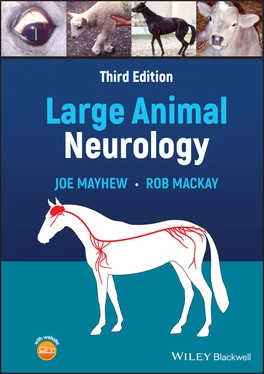Important facts to be noted include the duration and repetition of the episode of collapse, any exposure to various environmental factors such as recent lightning/thunder storm, proximity to stray voltage sources, excessive heat, poisonous plants, exogenous chemicals, previous or prodromal illness, different feeds, and whether other herd mates have been affected.
A brief physical examination can then be undertaken. The general aim at this stage is to determine which basic category of acute collapse best fits the particular case. 1These general categories include syncope and seizure ( Chapter 6), sleep disorders ( Chapter 7), coma, motor paralysis ( Chapters 23and 24), and generalized and metabolic disorders. 1Some of the characteristics of each of these are given here to assist in making an accurate diagnosis.
A small number of animals that experience one or more episodes of acute collapse are suspected of having syncope or a fainting condition. This suspicion is usually because of the presence of a cardiac arrhythmia or a cardiac murmur. Definitive cardiac disease is confirmed in a proportion of these cases. 2–4Such documented disorders include atrial fibrillation, ruptured chordae tendineae , myocardial infarction, myocardial fibrosis, dissecting aortic aneurysm, aortic endocarditis, and pericarditis.
With syncopal attacks, usually there is little or no premonitory warning of collapse; because of cerebral hypoxia, a temporary, quiet, comatose state ensues. Some struggling may occur during recovery, before the patient regains its footing, unless of course the patient has suffered severe head trauma on way to recumbency. Other overt signs of cardiac failure may become evident. Polycythemia 5and upper airway obstruction—including untoward effect of cribbing throat collar—rarely can also result in syncopal attacks. 6
A seizure , convulsion, or fit is the physical expression of bizarre but synchronous electrical neuronal discharges in all or part of the cerebrum and is introduced in Chapter 6. Often a preictal aura of a few seconds to minutes occurs, then the ictus or seizure lasts seconds to minutes with an accompanying variable period of coma or semicoma. This is followed by a postictal phase lasting several minutes to days. The initial aura may cause the animal to be distracted from its environment, to have a blank facial expression, and to occasionally become restless. If the seizure becomes generalized, the patient becomes recumbent and may lay rigid for a while before paddling or thrashing for several seconds to minutes. With status epilepticus , this phase is repeated continually and is fatal unless chemical, anticonvulsant restraint is used. A postictal animal usually regains its footing relatively easily then may pace, act blind, constantly drink or eat, and may not recognize herd mates, its handler, or its environment. Depending on the underlying cause, other neurologic signs may be evident. Anticonvulsant therapy may be required if more than one generalized seizure has occurred; although if familial juvenile epilepsy of Arabian foals is suspected, therapy can be started immediately.
Narcolepsy is characterized by uncontrolled episodes of sleep. Unlike seizures and many metabolic disorders, such as hyperkalemia and hypocalcemia, there are no warning signs. With multiple attacks, the patient may appear sleepy between episodes. Adult animals do not always drop to the ground in a paralyzed state of cataplexy and may catch themselves after the head suddenly lowers and the thoracic limb stay apparatus begins to fail. Most often prominent cataplexy, which entails sudden loss of all voluntary motor effort and somatic limb reflexes, occurs and the animal collapses to the ground. Petting about the head and neck, hosing down after exercise, beginning to eat or drink, and resting quietly in a barn at night all seem to have been associated or precipitating factors with various cases. Sleep attacks do not usually occur while an animal is exercising vigorously.
Coma is a state of recumbency with unconsciousness and total unresponsiveness. It is primarily associated with profound changes in the forebrain or midbrain. Head trauma, birth asphyxia, bacterial meningoencephalitis, thiamine‐responsive polioencephalomalacia, parasitic infarction/migration, spontaneous hemorrhage, moldy corn intoxication, liver disease, intracarotid injections, and many poisons are some of the more frequent causes of acute coma. Consequently, it is important to determine if the animal has a history or evidence of trauma or of other premonitory neurologic signs. Immediately following head trauma, a temporary period of coma often ensues. Thus, the animal does not require euthanasia during the first 24 h, but at this time appropriate diagnostic and therapeutic approaches should be instituted. Access to specific toxic compounds should be sought in order to administer appropriate antidotes that can be lifesaving. 7,8Future use of nanostructured biomaterials may well become generally available for unknown toxicities. 9
Collapse without loss of consciousness can be caused by loss of motor function. Motor pathways may be interrupted at the level of the brainstem, vestibular apparatus, spinal cord, peripheral nerve, neuromuscular junction, or muscle. A neurologic examination is needed to identify where the lesion is. Trauma is the most frequently occurring mechanism at the first three of these anatomic levels. Acute collapse without loss of consciousness is also caused by botulinum toxins including the shaker‐foal syndrome, postanesthetic myasthenic syndrome, postanesthetic neuromyopathy, exercise‐associated rhabdomyolysis, tick and elapid snake bite paralyses, and hyperkalemic periodic paralysis.
Generalized and metabolic disorders resulting in acute collapse include hyperthermia, cardiovascular collapse, hypoglycemia, hypocalcemia, hyperkalemia, hypokalemia, endotoxemia, intestinal hyperammonemia, anaphylaxis, anaphylactoid reaction, acute exotoxemia, snake envenomation, and many terminal toxic states. 10–15Usually, several body systems are found to be abnormal after a general physical examination and subsequent, appropriate detailed system examinations, and therapy can be undertaken.
1 1 Fejerman N. Nonepileptic disorders imitating generalized idiopathic epilepsies. Epilepsia 2005; 46 Suppl 9: 80–83.
2 2 Jesty SA and Reef VB. Evaluation of the horse with acute cardiac crisis. Clin Tech in Eq Pract 2006; 5(5): 93–103.
3 3 Lyle CH, Turley G, Blissitt KJ, et al. Retrospective evaluation of episodic collapse in the horse in a referred population: 25 cases (1995‐2009). J Vet Intern Med 2010; 24(6): 1498–1502.
4 4 Lyle CH and Keen JA. Episodic collapse in the horse. Equine Vet Educ 2010; 22(11): 576–586.
5 5 Steiger R and Feige K. Case report: polycythemia in a horse. Schweiz Arch Tierheilkd 1995; 137(7): 306–311.
6 6 Hay WP, Baskett A and Abdy MJ. Complete upper airway obstruction and syncope caused by a subepiglottic cyst in a horse. Equine Vet J 1997; 29(1): 75–76.
7 7 Landolt GA. Management of equine poisoning and envenomation. Vet Clin North Am Equine Pract 2007; 23(1): 31–47.
8 8 Khan SA, Kuster DA and Hansen SR. A review of moxidectin overdose cases in equines from 1998 through 2000. Vet Hum Toxicol 2002; 44(4): 232–235.
9 9 Muhammad F, Nguyen TDT, Raza A, Akhtar B and Aryal S. A review on nanoparticle‐based technologies for biodetoxification. Drug Chem Toxicol 2017; 40(4): 489–497.
10 10 Bandarra PM, Pavarini SP, Raymundo DL, et al. Trema micrantha toxicity in horses in Brazil. Equine Vet J 2010; 42(5): 456–459.
11 11 Ozmen O, Sahinduran S, Haligur M and Sezer K. Clinicopathologic observations on Coenurus cerebralis in naturally infected sheep. Schweiz Arch Tierheilkd 2005; 147(3): 129–134.
Читать дальше












